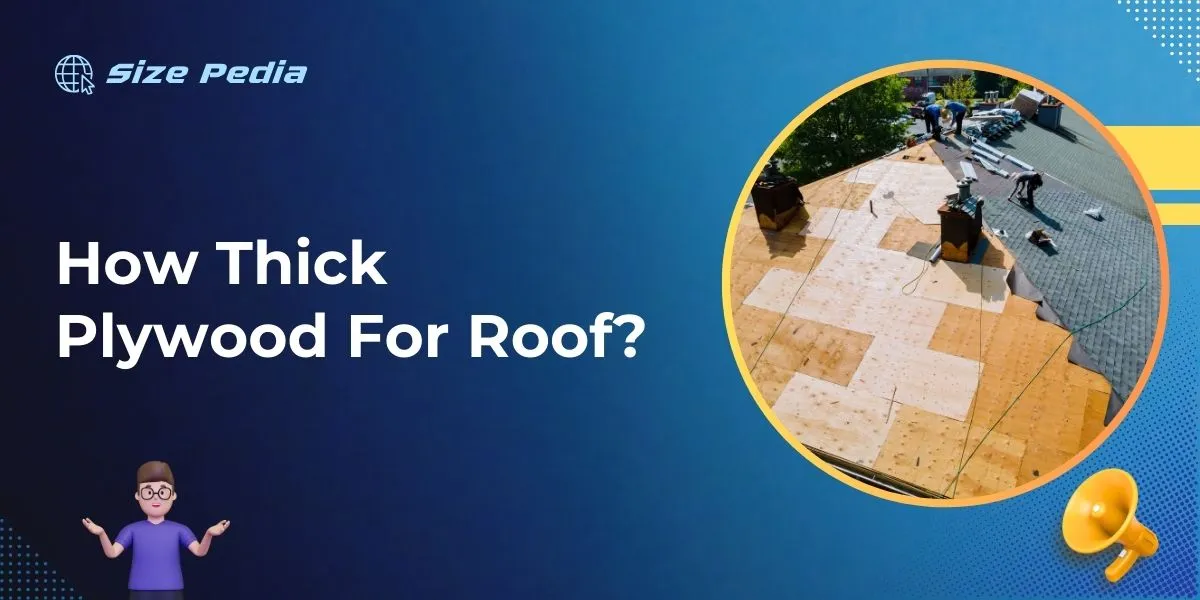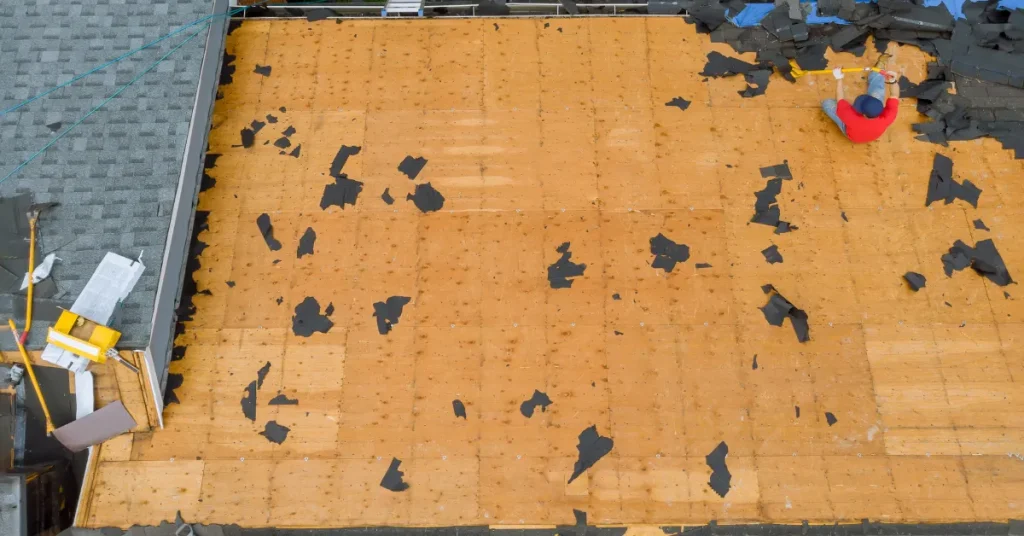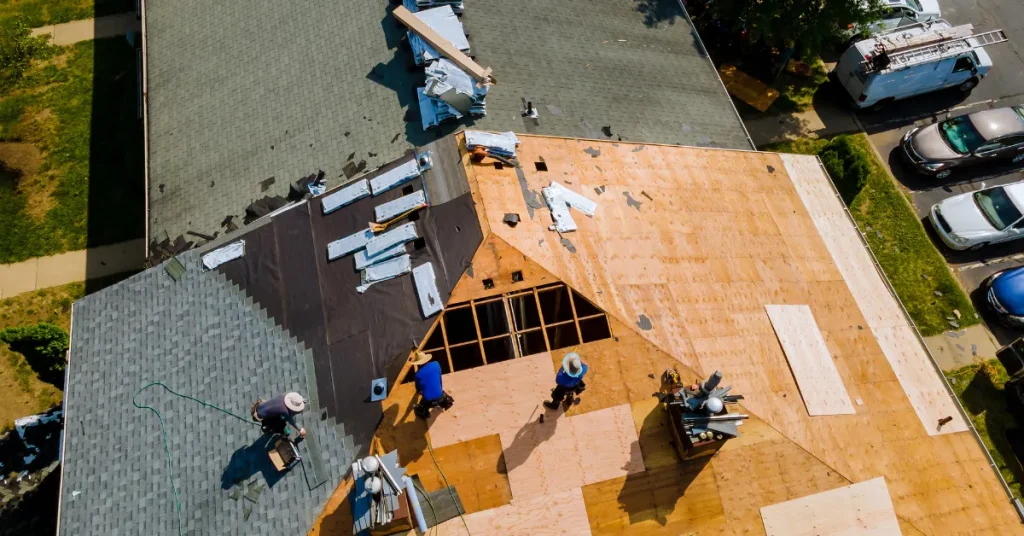For roofing, 1/2-inch plywood is the standard thickness. Roof sheathing typically requires 3/8 to 3/4 inch thick plywood, depending on the roof span and load.
Determining the appropriate thickness for plywood used on a roof is crucial for the structure’s integrity and safety. The choice of thickness impacts not only the roof’s durability but also its ability to withstand environmental stresses like wind, snow, and rain.
Proper roof plywood thickness ensures that the roofing materials have a solid foundation, leading to a longer lifespan for the roof overall.
Building codes often dictate the minimum requirements, which can vary by region and type of structure.
It’s essential to consult these regulations and, if necessary, seek guidance from a construction professional to ensure compliance and optimal roof performance.
Quality roof sheathing plays a pivotal role in protecting a home from the elements and providing a level base for roofing materials.

Plywood Basics In Roofing
Understanding the basics of plywood in roofing is crucial for durable and sturdy construction. Plywood serves as a foundational layer that supports roofing materials. Let’s dive into what makes it so essential.
Composition And Grades
Plywood is a versatile material made from thin wood layers, known as veneers, glued together. The direction of the wood grain alternates with each layer, providing strength and stability. Different plywood grades cater to various roofing needs:
- CDX – Commonly used for roofs, with one side graded ‘C’ and the other a ‘D’.
- OSB – Oriented Strand Board, similar to plywood, often used for roofing.
- Marine Grade – Highly durable against moisture but rarely used for roofing due to cost.
| Grade | Features | Common Use |
| CDX | Moisture resistant, sturdy | Roof decking |
| OSB | Consistent, cost-effective | Roof sheathing |
| Marine | Waterproof, strong | Specialized roofing |
Role In Structural Integrity
The role of plywood in a roof’s structure cannot be overstated. Plywood provides the base that supports shingles, metal, or other roofing materials. It evenly distributes weight and withstands the elements. For optimal structural integrity, consider these points:
- Select the correct thickness, typically 3/8 to 3/4 inches for residential roofs.
- Adhere to local building codes for compliance and safety.
- Ensure precise installation to prevent gaps and overlaps.
A sturdy roof protects a home from the top down, making the choice of plywood crucial. Suitable thickness and quality ensure a roof can withstand wind, rain, and other stresses over time.
Determining The Ideal Thickness

Selecting the correct thickness for plywood used in roofing is vital. It ensures durability and safety. Thickness impacts the roof’s ability to support weight, resist environmental stress, and provide insulation.
Factors To Consider
Choosing the ideal plywood thickness for roofing requires evaluation of several factors:
- Local weather conditions: Areas with heavy snowfall or high winds might need thicker plywood.
- Span between trusses: A longer span between the roof’s structural supports often necessitates thicker plywood to avoid sagging.
- Type of roofing material: Heavy materials like slate may require a sturdier base.
- Building codes: Adhering to local regulations ensures compliance and safety.
Industry Standards
The building industry recommends specific plywood thicknesses for roofing applications:
| Span (inch) | Recommended Thickness (inch) |
| 16 | 3/8 |
| 24 | 1/2 |
| 32 | 5/8 |
| 48 | 3/4 |
Following these standards minimizes the risk of structural failure. Proper installation and quality of plywood are key to a lasting roof.
Comparing Plywood Strengths
When choosing the right plywood for roofing, understanding the different strengths is key. Various types of plywood offer different levels of durability and support. Let’s explore how these strengths compare to help you make the best choice for your roofing project.
Strength Ratings
The strength of plywood is classified according to ratings like CDX, OSB, and more. CDX plywood is commonly used for roofing. The ‘C’ and ‘D’ refer to the quality of the wood on either side, while ‘X’ stands for exposure to elements. Here’s what you need to know:
- A-C: High-quality surface with a lesser-grade back.
- CDX: The most popular choice for roofing for its balance of quality and cost.
- OSB: Oriented Strand Board, strong and water-resistant.
Weight And Support Correlation
The weight of plywood affects its ability to support roofing materials. Thicker plywood means more weight but also means more support. The standard thickness for roof sheathing is 1/2 inch to 3/4 inch. Consider this table when choosing plywood:
| Plywood Thickness | Weight | Support |
| 3/8 inch | Lighter | Less Support |
| 1/2 inch | Moderate | Good Support |
| 5/8 inch | Heavier | Better Support |
| 3/4 inch | Heaviest | Best Support |
Matching the right thickness to your roof’s needs means a stronger, more lasting roof. Remember, heavy plywood adds strength but consult with a professional for the structure’s capacity.
Installation Best Practices
Ensuring your roof stands strong over the years depends greatly on using the right thickness of plywood and following installation best practices.
Plywood plays a pivotal role in providing structural support to your roof. Let’s dive into some key steps to follow for a safe and enduring installation.
Preparation And Safety Measures
Prior to commencement, gathering all necessary tools and safety gear is crucial. These measures prevent accidents and streamline the installation process.
- Wear protective gloves and eyewear.
- Secure a safety harness if working on steep roofs.
- Check weather forecasts to avoid wet conditions.
Preparing your workspace ensures a smooth operation. Clear the roof surface from debris and check that all framing is level and without damage.
Use a chalk line for accurate plywood alignment. Measure and cut your plywood appropriately to fit the roof’s configuration. This minimizes waste and ensures a snug fit.
Techniques For Enhanced Durability
Installing plywood for your roof requires attention to detail to boost longevity.
- Use appropriate thickness plywood, typically 3/8 to 3/4 inches, depending on the roof span and weight considerations.
- Stagger the plywood seams, creating a brick pattern for increased strength.
- Leave a 1/8 inch gap between sheets to allow for expansion.
- Secure the plywood using corrosion-resistant nails or screws.
- Apply a waterproof barrier to protect the plywood from moisture.
Ensure each piece of plywood is flush against the roof rafters and firmly attached. This prevents future warping or sagging.
Regular inspections and maintenance keep your roof in top condition. Catch issues early to avoid costly repairs. Reinforcing these best practices guarantees a robust and resilient roof framework.
Maintenance And Longevity Tips
When it comes to roof maintenance and longevity, using the right thickness of plywood is just the beginning. Proper care keeps a roof strong for years.
Regular checks and timely repairs protect your investment. Let’s explore how to maintain a plywood roof for lasting durability.
Routine Inspections
Spotting problems early can save your roof. Follow these easy inspection tips every season:
- Check for loose nails or screws.
- Look out for ply cracks or warps.
- Ensure seals and joints are tight.
- Clean debris from the roof surface.
- Trim overhanging branches that may cause damage.
Addressing Common Wear And Tear
A roof weathers daily wear and tear. Here’s what you can do to keep it in top shape:
| Issue | Signs | Action |
| Water Damage | Discoloration or sagging | Replace affected plywood. |
| Mold and Fungi | Dark spots or musty smell | Apply fungicide and improve ventilation. |
| Sun Damage | Fading or brittleness | Apply a reflective roof coating. |
Follow these smart maintenance steps to extend your roof’s life. A little effort prevents big expenses later.
Selecting The Right Plywood For Your Roof

Roofing projects require careful material selection. Plywood plays a critical role
in roof durability and reliability. Understanding the options for roofing ensures the best match for
your home. Here, explore cost-effective choices and eco-friendly alternatives.
Cost Versus Performance
The balance between expense and quality is crucial in plywood selection.
Plywood comes in various thicknesses and grades. Each has its own cost and
performance profile.
- Cheap options might lead to replacements soon.
- Premium choices provide longevity but at a higher price tag.
| Thickness (inches) | Typical Cost |
| 3/8″ | Less Expensive |
| 1/2″ | Moderate |
| 5/8″ | More Expensive |
| 3/4″ | Premium |
Evaluate your roof needs and choose wisely. Opt for a type that balances both the cost and your roofing requirements.
Environmental Considerations
Going green with your roof can save the planet and sometimes even your wallet.
Sustainable plywood comes from managed forests or recycled wood.
- Select FSC-certified plywood to ensure responsible sourcing.
- Consider plywood with low VOC (Volatile Organic Compounds) for healthier living spaces.
- Look for energy-efficient options that contribute to thermal insulation.
Eco-friendly plywood may cost more upfront. But it often leads to long-term savings.
It adds value to your property and helps conserve nature.
FAQs About How Thick Plywood For Roof
Should I Use 1 2 Or 3 4 Plywood For Roofing?
Use 1/2″ plywood for roofing on trusses or rafters set up to 16 inches apart. Opt for 3/4″ plywood if the support framework is 24 inches apart. Ensure plywood meets local building codes and load requirements.
What Is The Minimum Thickness For Roof Sheathing?
The minimum thickness for roof sheathing typically ranges from 3/8 inch to 1/2 inch, depending on local building codes and the spacing of the roof trusses or rafters.
Can You Use 3 8 Plywood For Roofing?
Yes, you can use 3/8-inch plywood for roofing, but it’s usually too thin for optimal support and durability. Most building codes recommend using at least 1/2-inch plywood for roofing projects to ensure stability and long-term performance.
Can You Use 15 32 Plywood For Roofing?
Yes, you can use 15/32-inch plywood for roofing, but ensure it meets local building codes and structural requirements for the intended load.
Conclusion
Selecting the appropriate plywood thickness for roofing is crucial. Aim for 1/2 to 3/4 inches to ensure durability and safety.
Remember, your local climate and roofing codes may necessitate adjustments. Choose wisely to protect your home for years to come.
Always prioritize quality for the best results.
Resources:
1. https://basc.pnnl.gov/resource-guides/structural-sheathing-plywoodosb-exterior-walls
